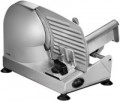Power
The total power consumption of the slicer. The value of this parameter is small — the performance of even the most powerful models usually does not exceed 200 W.
Almost all the power consumed is for operation of the engine, so the higher
it is, the more powerful the engine is installed in the slicer. Theoretically, the higher power allows you to better cope with solid and dense products, but in fact everything also depends on the characteristics of the knife — primarily its type (see below) and the quality of sharpening. Therefore, power data are more reference than practically significant, and this indicator has almost no effect on the quality of the slicer.
Blade type
The type of blade that comes standard with the slicer.
All knives used in this category of kitchen appliances are circular, rotating, and the blade in them goes in a circle. But the shape of this blade can be different — it is in this parameter that the types of knives differ from each other.
—
Straight. Knives with a traditional straight blade are basic and affordable, yet with proper sharpening and skill, they can handle various slicing tasks effectively. They excel with products of uniform consistency like cheese but may be less effective for slicing non-uniform density items such as bread compared to knives with wavy or notched blades.
—
Wavy. Knives with a wave-shaped blade are more difficult to manufacture and more expensive than straight ones. On the other hand, they do an excellent job not only with homogeneous products, but also with those that have different density — like ham with a crust.
—
Serrated. Serrated knives have sharpening in the form of pronounced sharp teeth, resembling those of a circular saw. They are beneficial for slicing products with varying density, similar to wavy blades. Serrated knives are particularly effective for cutting vegetables and fruits with tough peels and soft cores, like tomatoes or peaches. However, these knives tend to be more expensive due to their specialized design.
No
...te that some models may come with several removable blades of different types. This allows you to choose an option depending on the situation — for example, cut the cheese with a straight knife, and put the wavy one only when really necessary, so as not to wear it out much.Blade diameter
The diameter of the blade of the knife supplied with the slicer. Knives are shaped like discs — accordingly, the diameter of the blade is actually equal to the diameter of the disc.
The larger the blade, the larger ingredients the device can handle at a time and the “larger” the cut slices can be. At the same time, in fact it is rarely necessary to use a slicer for very thick products. Therefore, even in the most “large-caliber” modern models, the knife diameter usually does not exceed 300 mm.
Protection from accidental activation
The presence
of protection from accidental activation in the design of the slicer.
One of the most popular options for such protection is the use of two power buttons: in order for the knife to move, you need to hold down both. This format of work minimizes the chance of accidental start — for example, if you touch the button while correcting the cut product in the immediate near the blades. In addition, this function can also play the role of child lock: the buttons are often made quite tight so that only an adult can press them.

